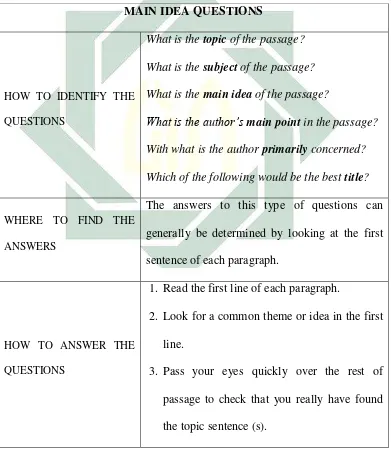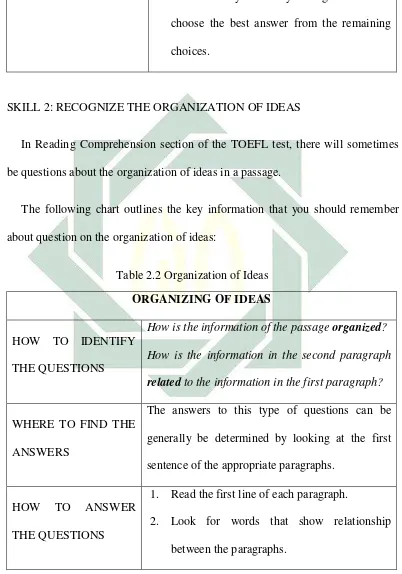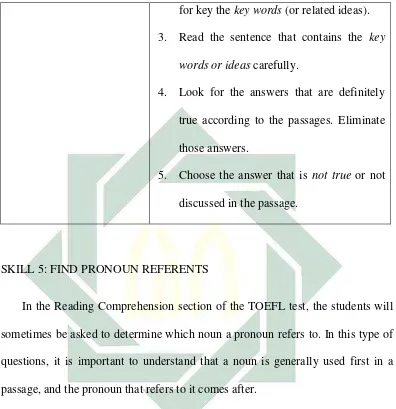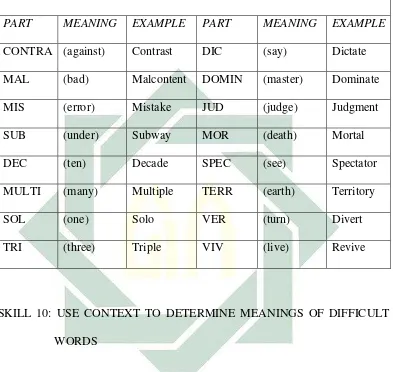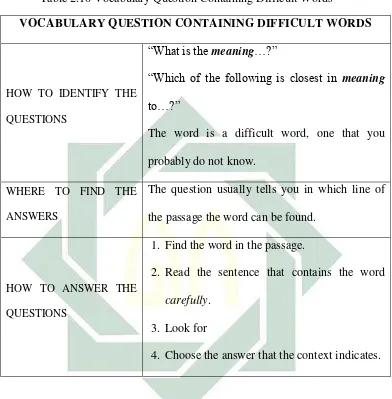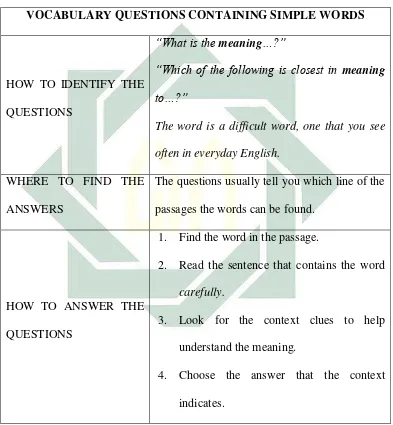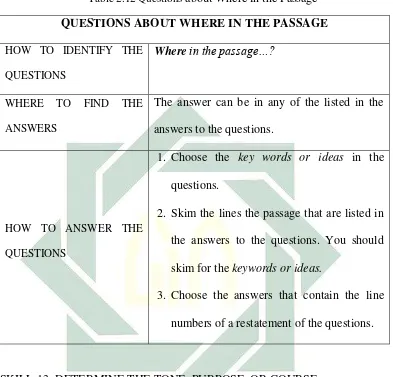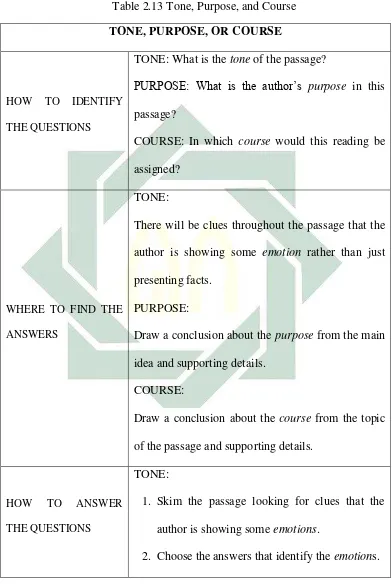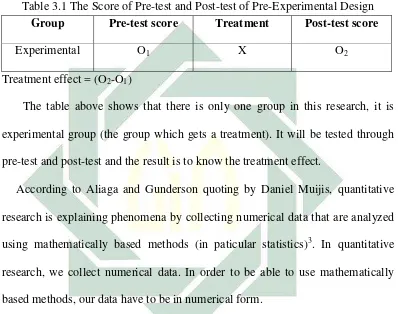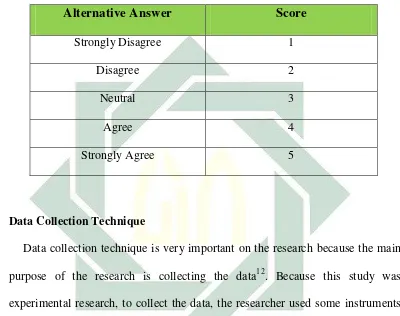THE EFFECTIVENESS OF READING
SKILL-BASED STRATEGIES FOR TOEFL TO
IMPROVE STUDENTS’ ACHIEVEMENT
SCORES OF TOEFL’S READING SECTION
AT UIN SUNAN AMPEL SURABAYA
THESIS
Submitted in partial fulfillment of the requirement for degree of
Sarjana Pendidikan (S.Pd.) in Teaching English
By:
Lathifatul Ainiyyah
NIM. D95211085
ENGLISH TEACHER EDUCATION DEPARTMENT
FACULTY OF EDUCATION AND TEACHER TRAINING
SUNAN AMPEL STATE ISLAMIC UNIVERSITY
THE EFFECTIVENESS OF READING
SKILL-BASED STRATEGIES FOR TOEFL TO
IMPROVE STUDENT
S’ ACHIEVEMENT
SCORES OF TOEFL READING SECTION
AT UIN SUNAN AMPEL SURABAYA
THESIS
Submitted in partial fulfillment of the requirement for degree of
Sarjana Pendidikan (S.Pd.) in Teaching English
By:
Lathifatul Ainiyyah
NIM. D95211085
ENGLISH TEACHER EDUCATION DEPARTMENT
FACULTY OF EDUCATION AND TEACHER TRAINING
SUNAN AMPEL STATE ISLAMIC UNIVERSITY
I'IIITNYATAAI{
\.:'..1 r's11g bertanda tangan di barvalt
".,,ina
: Lalhifatul AiniyyalrKIIASLIAN TULISAN
ini:
\l\1
\.J III CSTCT
: D9521 I 085
: VIII (Dclapan)
' .rl.Lrltus/ l)rocli: 'l'arbivuh rlan I(cguruan/ [)cndicli]<an Ilahasa Inggris
-,''-'ngan
ini
menyatal<.an seberrar-benarnya bahrva sliripsi yang berjudul "Tlte L.l.'/bctiveness of Reudittg Skill-Bused Strategies Jbr TOEFL to Imltrove Stutlents' .lcltievemeril Scores of TOIiFL Reoding Sectiort at UIN Sunon Ampel Surahuyu .'lcnrlenic Year 2014-2015" aclalah beuar-bcnar merupakan hasiI liarya sendiri, bul<an rre-rLtpakan pengaurbil-alihan tr-rlisan atau pikiran oraug laiu yang saya akui sebagaiirusil lulisan atar-r pihiran ser"rcliri. Segala rnateri yang cliarnbil clari karya orang Iain
irartr''a digunakau sebagai acuzrn clengan nrengikuti tata cara dan etika penulisan karva
r lnriah yang ditetapkan oleh.julusan.
Derrikian pcrnyataan
ini
dibuat dengan sebenar-benantya, mal<a selaku penulis bcrsedia dimintai pertangglurg jarvaban sesuai ketentuan peratllran perundang-Lrnclangan.t,ttr,rl,rt)rr.
ll
.ltrii lt) l 'NrM. D9s2l r 08s
lx
\ I i,.tr,. l
!.
iffii=
APPROVAI, SHEET
This thesis by Lathifatul Ainiyyah entitled "The Effictiveness of Reacling S:::ll-based Strategies
for
T1EFLto Improve
Students' Achievement Scores of loEFL's Reading section at LIIN sunan Ampel Surabaya" has been approved by the :hesis advisors for further approval by the board of examiners.Surabaya, July 2Sth 2105
Advisor
I
NrP. 1971 0302 199603 1002
Advisor
II,
EXAMINERS APPROVAL SIIEET
Thesis Entitled
, i
IE
EFFECTIVENESSOF
READING SKILL-BASED STRATEGIES FOR.
IEFLTO
IMPROVE STUDENTS' ACHIEVEMENT SCORESOF
TOEFL.I:,.\DING
SECTIONAT UIN
SUNAN AMPEL SURABAYA" accepted and.::rtroved by the board
of
examinersof
English Teacher Education Department ,,cultr,of Tarbiyah
and leaghsr Training g SuSunan Ampel State islamic amlc UniversiLlnlversrtv . ,.raba),a.The board of Examiner Examiner I,
li Mudlofir. M.A 19631 I 161989031003
S==-nnrU,D
Prof. Arief Furqon. MA. Ph.D NIP. 194708091967081001
Examiner III, ./
NIP. 197103021996031 002
NrP. 19840914200912200s iner II.
Masdar
ulniMeYrr.p
Examiner IV,
ABSTRACT
Ainiyyah, Lathifatul. (2015). The Effectiveness of Reading Skill-Based Strategies for TOEFL to Improve Students’ Achievement Scores of TOEFL Reading Section at UIN Sunan Ampel Surabaya Academic Year 2014-2015. A Thesis. English Teacher Education Department, Faculty of Education and Teacher Training, Sunan Ampel State Islamic University Surabaya. Advisor: Masdar Hilmy, MA., Ph. D.
Key Words: TOEFL, Reading Section, Reading Strategy, Reading Skill-Based Strategy for TOEFL, Students’ Achievement Scores
ABSTRAK
Ainiyyah, Lathifatul. (2015). The Effectiveness of Reading Skill-Based Strategies for TOEFL to Improve Students’ Achievement Scores of TOEFL Reading Section at UIN Sunan Ampel Surabaya Academic Year 2014-2015. Skripsi. Jurusan Pendidikan Bahasa Inggris, Fakultas Tarbiyah dan Kejuruan, UIN Sunan Ampel Surabaya. Pembimbing: Masdar Hilmy, MA., Ph.D.
Kata Kunci: TOEFL, Reading Section, Reading Strategy, Reading Skill-Based Strategy for TOEFL, Students’ Achievement Scores
TABLE OF CONTENT
TITLE SHEET ... i
APPROVAL SHEET ... ii
EXAMINERS APPROVAL SHEET ... iii
MOTTO ... iv
DEDICATION SHEET ... v
ABSTRACT ... vi
ACKNOWLEDGMENT ... vii
PERNYATAAN KEASLIAN TULISAN ... ix
TABLE OF CONTENT ... x
LIST OF TABLE ... xii
LIST OF PICTURES ... xiii
LIST OF APPENDICES ... xiv
CHAPTER I: INTRODUCTION A. Research Background ... 1
B. Research Questions ... 9
C. Hypothesis of the Study ... 9
D. Objectives of the Study ... 9
E. Significance of the Study ... 10
F. Scope and Limit of the Study ... 11
G. Definition of Key Term ... 11
CHAPTER II: REVIEW OF RELATED LITERATURE A. Reading ... 14
1. Definition of Reading ... 14
2. The Descipline of Reading ... 16
3. Reading Comprehension ... 17
4. Reading Strategy ... 19
B. TOEFL ... 20
1. Definition of TOEFL ... 20
2. Paper Based TOEFL (PBT) ... 22
3. Question Types in TOEFL Reading Comprehension ... 25
C. Reading Skill-Based Strategies for TOEFL ... 28
CHAPTER III: RESEARCH METHOD
A.Research Design ... 53
B.Research Variable ... 56
C.Research Subjects ... 56
D.Research Instruments ... 58
E. Data Collection Technique ... 60
F. Data Analysis Technique ... 62
CHAPTER IV: FINDINGS AND DISCUSSION A.Research Findings ...65
1. The Effectiveness of Reading Skill-Based Strategies for TOEFL to Improve Students’ Achievement Scores of TOEFL Reading Section ...65
2. Students’ Responses after Studying Reading Skill-Based Strategies for TOEFL...74
B.Discussion ... 91
1. The Effectiveness of Reading Skill-Based Strategies for TOEFL to Improve Students’ Achievemet Scores of TOEFL Reading Section ...92
2. Students’ Responses after Studying Reading Skill-Based Strategies for TOEFL ...94
CHAPTER V: CONCLUSION AND SUGGESTION ... 95
A. Conclusion ... 95
B. Suggestion ... 97
REFERENCES ... 98
CHAPTER I
INTRODUCTION
A. Research Background
In academic issue, most people have heard about TOEFL test or even done
it, even TOEFL has become very popular in the world. Educational Testing
Service (ETS) announced TOEFL as the most widely-used and internationally
recognized test to evaluate non-native English speakers‟ language proficiency1.
The statement from Educational Testing Service gives a reality that TOEFL is
used in all over the world to test English proficiency of people who live in
non-English speaking countries. Because of widely used and internationally
recognized test, TOEFL is used all over the world included in Indonesia.
There are main perspectives for understanding the nature of reading
comprehension: the task perspective, the processing perspective, and the reader
purpose perspective2. In short, as Cohen has noted, in order to assess reading
comprehension in a second or foreign language, it is necessary to have a working
knowledge of what the process entailed. We must demonstrate that these
inferences are appropriate for the decisions we need to make. Consequently, it is
1
Michael J, Education Testing Service Standard Setting Materials for the Internet-based TOEFL Test(Princeton: ETS Press, 2005), 5
2
2
important to have good insight into what people who take reading comprehension
tests to do in order to complete them3.
One of the most serious problems in higher education, but one which is often
not recognized by either students or lecturers until some ways into academic
courses, is the problem of reading, perhaps because reading is not assessed.
However, the results or outputs from reading are assessed4. Actually, most of the
students have some problems in their learning, especially in reading section.
They can read the texts well because it doesn‟t need any assessments. Usually,
the assessment of reading is when we comprehend the content of text, understand
the meaning and the purpose of the text and answer the questions well if it is
needed to be answered.
The ability to read academic texts is considered as one of the most important
skills that university students of English as a Second Language (ESL) and
English as a Foreign Language (EFL) need to acquire5. Reading comprehension
has come to be the essence of reading. Essential is not only to academic learning
in all subject areas, but also to professional success and indeed to life long
learning.
3
Andrew Cohen, An Assessing Reading Comprehension (New York: Predicy Press, 1994), 20 4
Carisma Dreyer and Charl Nel, Teaching Reading Strategies and Reading Comprehension within a Technology-Enhanced Learning Environment (South Africa: Faculty of Education Sciences, 2003), 249-250
5
3
It is important for us to use English as a Second Language (ESL) because as
we have known that English is international language that most of people in the
world use English as a First Language (EFL). We may not fail, we have to keep
in trying. To comprehend the text, we must focus on reading comprehension.
Reading comprehension is an essence of reading. Without comprehending the
texts, we cannot get the point and understand the content and the purpose of the
texts. Not only academic texts, but also the others, we have to be able to
comprehend the texts, especially if we want to comprehend the texts included in
TOEFL test. To comprehend the texts, we also need the strategies. One of them
is the strategy of TOEFL‟s reading section.
Chelsea states that TOEFL exam does not only test the English language
mastery, but also test-taking skill6. In this case, TOEFL is useful for the students
who want to master English as well as possible. Besides, it is also useful to
improve their skills of answering the questions of TOEFL test. In this part, the
researcher wants to research TOEFL reading section. From preliminary research,
it is found that the students have some problems in the reading section of TOEFL
test. They are they get the difficulties to understand the sentences, they get bored
while reading the text, they cannot manage the time as well as possible, and they
are also unfamiliar with the words that have been read. Therefore, They need
6
4
some strategies to solve those problems. It is reading skill-based strategies for
TOEFL.
Reading section of TOEFL test contains passages on a variety of subjects.
Following each passage consists of several questions about the passage7. In this
section, the students will get the questions and written texts that are different
each other. Therefore, the students need the ability to comprehend the message
that delivers in the passage. Most of students are usually lazy to read the passage
because of the content and time limit. Some of them have their own strategies to
answer the questions as well as possible. This section examines your knowledge
to understand some kinds of scientific reading that related to topic, main idea,
reading content, meaning or some word groups and detail information that
related to the text8. A number of questions were 50 questions for 55 minutes. In
this section, we are demanded to have much knowledge, especially reading. We
have to read the books as many as possible. Beside reading books, we should
also understand the contents of those as like the topic, main idea, meaning and
the others.
The researcher has found six previous studies which have done regarding
TOEFL, reading, and reading strategy. Three of them deal with TOEFL and three
of them deal with reading and reading strategy. The first previous study was
conducted by Andrew D. Cohen and Thomas A Upton focusing on the reading
7
Peterson, Master TOEFL Reading Skill (United States of America: A Nelnet Company, 2007), 3 8
5
and test-taking strategies that test takers used in the Reading section of the
Language courseware. The investigation focused on strategies used to respond to
more traditional single selection multiple-choices formats (i.e., Basic
Comprehension and Differencing Question) and the new selected-response
(multiple selection, drag and drop) reading to learn items9.
Different with the research which belongs to Elis Rahmawati‟s, it analyzed
test-taking strategies use in TOEFL equivalent test by the sixth semester students
of English Teacher Education Department UIN Sunan Ampel Surabaya before
and while doing TOEFL equivalent test10. Furthermore, Feni Rahmawati‟s
research found out students‟ perception of time management behavior that used
by the students in reading section on TOEFL test and what question types that
most influence students‟ perception about time management behavior in reading
section on TOEFL preparation test11.Carol A. Fraser additionally conducted
which reported on a strategy training study that investigated the lexical
processing strategies used by second learners when they encounter unfamiliar
99
Andrew D. Cohen and Thomas A Upton, Response Strategies on Reading Subtest of the New TOEFL
(Indianapolis: Indiana University, 2002) 10
Elis Rahmawati, Undergraduate Thesis: An Analysis of Test-Taking Strategies use in TOEFL Equivalent Test by Sixth Semester Students of English Teacher Education Department UIN Sunan
Ampel Surabaya Academic Year 2013-2014 (Surabaya: UIN Sunan Ampel Surabaya, 2014), 135137
11
Feni Rahmawati, Undergraduate Thesis: Students’ perception about time management behavior in
reading section on TOEFL Preparation Test at UIN Sunan Ampel Surabaya Academic Year 2013-2014
6
vocabulary while reading and the impact of these strategies on vocabulary
learning12.
Next previous study conducted by Carisma Dreyer and Charl Nel that
discussed about teaching reading strategies that used to develop reading skill of
South African students who have low levels and also improve their ability in
reading comprehension within a technology-enhanced learning environment13.
Another study was conducted by Batia Laufer who stated that reading
comprehension and vocabulary comprehension were the same, or reading quality
was determined by vocabulary alone. Reading comprehension was also affected
by textually relevant background knowledge and the application of general
reading strategies such predicting the content of the text, guessing unknown in
context, making inferences, recognizing the type of text and text structure14.
However, this research has distinctive focus from those previous studies.
Different with previous studies from Cohen and Upton, Elis and Feni, This
research tries to measure the extent to which reading skill-based strategies for
TOEFL can improve students‟ achievement scores of TOEFL‟s reading section
based on Philip‟s theory. Besides, this study aims to investigate students‟
response after studying reading skill-based strategies for TOEFL, dissimilar with
12 Carol A. Fraser, “Lexical Processing Strategy Use and Vocabulary Learning through Reading”,
Studies in Second Language Acquisition,Vol.21, Issue 02, 1999, 225 13
Carisma Dreyer and Charl Nel, (2003), “Teaching Reading Strategies and Reading Comprehension within a Technology-enhanced Learning Environment”, Individual Differences: Advancing Knowledge, Vol.31, Issue 3, 2003, 349
14
7
the other three previous studies that conducted by Fraser, Drayer and Laufer that
discussed about different kinds of reading and reading strategy.
English Teacher Education Department of Sunan Ampel State Islamic
University Surabaya is one of the departments in Indonesian Universities that
obligated their students to achieve the English Proficiency score at least 500 as
the graduation requirement. Moreover, it is found that some students complain in
reading section, they feel bored and less interseted on reading section because of
many words to read and understand and they should answer it within fifty five
minutes on fifty questions. They need TOEFL reading strategies to solve the
problems. Furthermore, in English Teacher Education Department, there is also
the class that used to prepare the students to join TOEFL test. Therefore, it is
good if the researcher can make the research in this area.
Because of some reasons above, the researcher wants to know whether
reading skill-based strategies for TOEFL are effective to improve students‟
achievement scores of TOEFL reading section for students in the sixth semester
of English Education Department Faculty of Education and Teacher Training of
Sunan Ampel State Islamic University. Reading skill-based strategies for TOEFL
that are used in this study is proposed by Deborah Philips at the title “Longman
Preparation Course for the TOEFL test”.
The researcher uses the theory of longman book because it is intended to
prepare the students for TOEFL test. It is based on the most up-to-date
8
on July 199515. Besides, it also consists of complete language skills instruction
for skills which was tested on both TOEFL paper test& test of written English
and diagnostic pre-tests & evaluation post-tests for each section that allow
students to identify their strengths and weaknesses. It is practice exercises for
each of the language skills that maximize understanding and retention that is
effective for the students who want to join TOEFL test16.
Researching the effectiveness of reading skill-based strategies for TOEFL at
English Teacher Education Department UIN Sunan Ampel Surabaya will be very
important. The first importance is people will be able to measure the extent to
which reading skill-based strategies for TOEFL to improve students‟
achievement scores of TOEFL‟s reading section. If the result of this study shows
that those strategies are effective to improve students‟ achievement scores of
TOEFL‟s reading section, it means that those strategies are successful to be
taught and can be practiced while doing TOEFL Test of reading section. The
second importance is that people can investigate students‟ response after
studying reading skill-based strategies for TOEFL. If the responses are positive,
it means that reading skill-based strategies for TOEFL are good and can be
practiced.
15
Deborah Philips, Longman Complete Course for the TOEFL Test: Preparation for the Computer and
Paper Test (NY: Pearson Education Company, 2001)
16
9
B. Research Questions
Based on the research background, the research questions of this study were:
1. Are reading skill-based strategies for TOEFL effective to improve students‟
achievement scores of TOEFL reading section?
2. What are students‟ responses after studying reading skill-based strategies for
TOEFL?
C. Hypothesis of the Study
Hypothesis of this study was based on the research questions as follows:
H0 : Reading skill-based strategies for TOEFL are not effective to
improve students‟ achievement scores of TOEFL reading section.
H1 : Reading skill-based strategies for TOEFL are effective to improve
students‟ achievement scores of TOEFL reading section.
D. Objective of the Study
Based on the research questions above, the researcher has formulated the major
objectives of this research. They were:
1. To know whether reading skill-based strategies for TOEFL are effective to
improve students‟ achievement scores of TOEFL reading section.
2. To investigate students‟ responses after studying reading skill-based
10
E. Significance of the Study
The significances of this study were as follows:
1. Theoretical Significance
a. The result can give knowledge to the lecturer about reading skill-based
strategies for TOEFL and students‟ responses after studying those
strategies.
b. The students can know the extent to which reading skill-based strategies
for TOEFL can improve students‟ achievement scores of TOEFL‟s reading
section and what students‟ responses after studying those strategies.
c. The result of this research can give the readers an additional knowledge
about reading skill-based strategies for TOEFL that can be learned and
practiced while doing TOEFL test.
2. Practical Significance
a. The result of this research can be useful for teaching TOEFL, especially for
reading section.
b. The result of this research can be useful to help lecturer who teach TOEFL
to encourage the students to practice reading skill-based strategies for
TOEFL when doing TOEFL test of reading section.
c. The result of this research can be useful as a reference for the researcher
who wants to conduct a researchto measure to what extent reading
skill-based strategies for TOEFL can improve students‟ achievement scores of
11
F. Scope and Limitation of the Study
The scope of this study was the effectiveness of reading skill-based strategies
for TOEFL to improve students‟ achievement scores of TOEFL‟s reading
section. The reading skill-based strategies for TOEFL that used in this research
are proposed by Deborah Phillip in his book entitle“Longman Preparation
Course for the TOEFL Test.”
The limitation of this study was the students of sixth semester of English
Teacher Education Department UIN Sunan Ampel Surabaya academic year
2013-2014 who join TOEFL Preparation Class and get the lesson of reading
skill-based strategies for TOEFL. In this research, the researcher only takes one
class from three classes. It is “B” class.
G. Definition of Key terms
To avoid misuderstanding in the way to understand this study, the researcher
tried to explain some related terms as follows;
1. TOEFL
It is defined as the abbreviation of Test of English as a Foreign Language
that examines how far the students can master English that includes Listening
Comprehension, structure and written expression and reading
comprehension17. In this case, TOEFL can be defined as the test that held by
the lecturer of TOEFL subject to evaluate English language proficiency of the
17
12
sixth semester students of English Teacher Education Department and the
kind of TOEFL test is Paper Based TOEFL (PBT).
2. Reading Section
It is designed to examine students‟ knowledge in understanding some
kinds of scientific texts that related with the topic, main idea, content of text,
meaning of words or phrase and also detailed information of text18. In this
case, reading section is one of the sections in TOEFL and the material of
reading section is held by the lecturer of TOEFL.
3. Reading Strategy
It is a cognitive or behavioral action with the goal of improving some
aspects of reading comprehension19. In this case, reading strategy is the
strategy that used by the students to comprehend the text entirely and can
answer the questions of reading.
4. Reading Skill-Based Strategy for TOEFL
It is a strategy that is proposed by Longman to help the students to be
able to answer the questions of TOEFL‟s reading section by identifying some
kinds of questions based on the skills20.
18
Slamet Riyanto, Test Strategy for Reading Comprehension, (Yogyakarta: PutakaPelajar, 2007), 4 19
Carisma Dreyer, Teaching reading strategies and reading comprehension within a
technology-enhanced learning environment, (South Africa: Potchefstroom 2520, 2003), 350
20
13
5. Student’s achievement score
It is defined operationally as the average of student‟s scale score,
inclusion of an achievement level21. In this case, the researcher gives a
definition of students‟ achievement scores as the improvement of students‟
scores before and after getting the treatment.
21
S. Paul Wright, Sandra P. Horn, and William L. Sanders, Teacher and Classroom Context Effects on
Students Achievement: Implications for Teacher Evaluation, (Boston, Netherlands: Kluwer Academic
CHAPTER II
REVIEW OF RELATED LITERATURE
In this chapter, the researcher explains about the theories related to the study that
has strong relation with the topic. This chapter includes the review of related
literature that deals with reading, TOEFL (Test of English as a Foreign Language),
reading skill-based strategies for TOEFL and some previous studies that related to
this study.
A. Reading
In the part of reading, the researcher wants to give the theories about
definition of reading, the discipline of reading, reading comprehension and reading
strategy.
1. Definition of Reading
Reading is an extraordinary achievement when one considers the number of
levels and components that must be mastered. Consider what it takes to read a
simple story. The words contain graphemes, phonemes and morphemes. The
reader needs to distiguish given versus new informationin the text and
implicitly aknowledge what is shared among most readers in a community1.
Reading is different from writing. Writing prioritizes sound, as the spoken
word must be transformed or deconstructed into representative sign, but reading
1
15
prioritizes meaning2. In its most general modern definition, reading is of course
the ability to make sense of written or printed symbols. The reader uses the
symbol to guide the recovery of information from his or her memory and
subsequently uses this information to construct a plausible interpretation of
writer‟s message3 .
The research of power of reading and spelling said that more reading is
better spelling4. It means we have to provide more time for reading in order to
we have a good spelling. Children can spell a substantial number of words they
haven‟t been directly taught, in this section, the researcher wanted to encourage
students to spell correctly in all situations to avoid developing bad habit.
Reading is one of the most important skills. Students usually get bored if
they are faced the text. Therefore, in order to make them not bored again, they
are taught some strategies of reading. Even at the university level, it is often
assumed that students have the skills and strategies needed to successfully
comprehend expository text5.
2Uta Frith, „Reading by Eye and Writing by Ear’, in P.A. Korles, M.E. Wrolstad and H. Bouma, eds, Processing of Visible Language (New York: 1979) pp. 379-90.
3D.C. Mitchell, The Process of Reading: A Cognitive Analysis of Fluent Reading and Learning to Read
(Chichester and New York: 1982)
4
Stephen Krashen, The Power of Reading: Insights from the Research, (Observation and Reflections from BEHS Staff, October 2004)
5
Carisma Dreyer, Teaching reading strategies and reading comprehension within a technology
16
Reading comprehension examines students‟ knowledge in understanding
some kinds of scientific texts that related with the topic, main idea, content of
text, meaning of words or phrase and also detailed information of text6.
2. The Discipline of Reading
We can begin to look at the discipline of reading from the vantage of these
higher expectations7:
a. Approaching the text
In this point, the writer recommends the readers to be able to understand
and comprehend the text and the organization of the text that will help them
to make the expectation and also to approach all of the information that
included in the text.
b. Practical Skills of Reading
The practical skills of reading are annotation, word searches and directed
questioning.
1) Annotation
Annotation is the commentary of what have been read literally
conducted right there on the page. The commentary should be directed
partly to understanding the materials and partly to forming responses and
fashioning analysis. It involves underlining important words, phrases, or
sentences because annotation is an active process. It is better done with a
6 Slamet Riyanto, Test Strategy for Reading Comprehension (Yogyakarta: Putaka Pelajar, 2007), 4 7 Igor Webb, Ideas Across Time “Classic and Contemporary Readings for Composition” (New York:
17
pen or pencil than a highlighter. A highlighter can be used to identify key
passages or words, but it is cumbersome for writing down questions or
ideas.
2) Word Searches
Word searches are probably searching a word from specialized
vocabulary or word outside the usual contexts of reading. It is a word.
Therefore, the readers have to know the meaning that can be done using
dictionary.
3) Directed Questioning
A good reader is alert to suggestion, implication, confusion and
contradiction in a piece of writing. A powerful piece of writing naturally
triggers responses in the reader, not just at the conclusion of the essay or
the climax of the story, but each step of the way.
3. Reading Comprehension
Comprehension requires making meaning from words when listening,
speaking, reading and writing. Good readers have a purpose for reading and
use their experiences and background knowledge to make sense of the text.
Making connections is the key to comprehension. We don‟t comprehend
unless we make connections and are able to process the words that we read at
the thinking level. Comprehension is the center of reading. Up to the end of
3rd grade, children are learning to monitor their own level of comprehension
18
Reading comprehension is dependent on three factors. The first factor is
that the reader has command of the linguistic structures of the text. The
second factor is that the reader is able to exercise metacognitive control over
the content being read. This means that the reader is able to monitor and
reflect on his or her own level of understanding while reading the material.
The third and most important criterion influencing comprehension is that the
reader has adequate background in the content and vocabulary being
presented8.
When an effective reader reads for comprehension and understanding, it
is an actively engaged and thoughtful process. One of the things that good
readers do during the reading process is to make connections between
background knowledge and the new information in the text. Readers filter new
information against their own background storehouse of information and life
experiences and identify and sift relevant from non-relevant information.
Effective readers monitor when the text is not understood or is not making
sense and repair faulty comprehension whenever it occurs.
Good readers make inferences during and after reading and are adept at
synthesizing information within across texts. In addition to categorizing
information, effective readers use prediction and draw conclusions from
explicit as well as from implicit information. Effective readers visualize the
8
19
information in the text as they read and create images using the different
senses to better understand what is read.
4. Reading Strategy
A reading strategy is a cognitive or behavioral action that is enacted under
particular contextual conditions, with the goal of improving some aspects of
comprehension9. Teachers often instruct students to look up a word in a
dictionary when they encounter a rare word with which they are unfamiliar.
Conducted from the article entitled “Can reading strategies be
successfully taught?” written by Patricia L.Carrell, it‟s explained that Reading
strategies are of interest not only for what they reveal about the ways readers
manage their interactions with written text, but also for how the use of
strategies is related to effective reading comprehension. The readers do exert a
significant level of active control over their reading process through the use of
strategies, which are conscious procedures that are deliberate and purposeful.
According to Garner, reading strategies can be defined as generally
deliberate, planful activities undertaken by active learners, many times to
remedy perceived cognitive failure, facilitate reading comprehension and may
be teachable10. Garner concurred with Paris, Lipson, and Wixon that reading
strategies can and should be learned to the point of automaticity, after which
9Carisma Dreyer, Teaching reading strategies and reading comprehension within a technology
-enhanced learning environment, (South Africa: Potchefstroom 2520, 2003), 350
10 R. Garner, Theoretical Model and Processes of Reading 4th Ed., (Newark, DE: International Reading
20
they become skills, and that learners must know not only what strategies to
use but also when, where, and how to use them.
B.TOEFL (Test of English as a Foreign Language)
1. Definition of TOEFL
TOEFL is an exam required by most US and Canadian university to prove
proficiency (especially International students coming from countries where
English is not native language). It measures your listening, reading, speaking,
writing skills to perform academic tasks in English. The purpose of TOEFL
itself is to evaluate English proficiency of people whose native language is not
English. The test was initially developed to measure English proficiency of
Internasional students11.
The TOEFL test formerly known as the “Test of English as a Foreign
Language” was developed in the early 1960‟s to assess the English proficiency
of nonnative where English is the language of instructions12. Restating what the
researcher defines about TOEFL is important to lead the readers going deeper
into TOEL areas. According to Cambridge Advanced Learner‟s Dictionary,
“TOEFL is abbreviation for Test of English as a Foreign Language: an exam of
English for speakers of other languages13.
11TOEFL Programs and services , (Educational Testing Service: 2000) 12TOEFL Ibt Research Insight. Series 1, vol.6
13 Author, Cambridge International Dictionary of English Third Edition (UK: Cambridge University
21
On other hand, Educational Testing Service/ETS announced TOEFL as the
most widely used and internationally recognized test to evaluate non-native
English speakers‟ language proficiency14. Meanwhile, Longman TOEFL
Preparation defines TOEFL as a test to measure the level of English proficiency
of nonnative speakers of English, it is required by English-language Colleges
and Universities15.
The content of the manual are equally relevant for the paper-and the
computer-based tests). Moreover, there are no passing scores on TOEFL test
because various institutions have their own TOEFL score requirement16. It
means that somebody wants to apply in University that requires TOEFL score,
the applicants should achieve the score required.
In Longman, it is also explained that there is relationship between paper
based TOEFL score and Computer Based TOEFL such as 677 points in paper
same as 300 in computer, 650 pints in paper same as 280 points in computer,
600 points in paper is same as 250 in computer, 550 in paper is same as 213 and
14
Author, Educational Testing Service Standard Setting Materials for the Internet-Based TOEFL Test
(NJ: Princeton, 2005)
15 Deborah Philips, Longman Complete Course for the TOEFL Test: Preparation for the Computer and Paper Test (N.Y: Pearson Education Company, 2001)
16 Pamela J. Sharpe, Barron S: Practice Exercise for the TOEFL Test 3rd Ed. Kaset 2 (Indonesia:
22
soon17. In addition, TOEFL test is intended to evaluate certain aspects of the
English language proficiency of people who native language is not English18.
2. Paper Based TOEFL (PBT)
TOEFL PBT preparation is designed for advanced students seeking
admission to college/ university who need a TOEFL score of 500 for under
graduated studies or 550 for graduate programs19. It is a rigorous course
focusing on three skill areas tested: Listening Comprehension, Structure and
Written Expression, and Reading Comprehension. There is no speaking or
essay-writing on PBT TOEFL and the entire test is in multiple-choice format,
so the course concentrates on the recognition skills and speed needed for this
kind of exam.
The reading comprehension section of TOEFL test is designed to measure
students‟ ability to read and understand short passages in English. Reading
comprehension is the third section in both TOEFL PBT and TOEFL CBT, and
the first section in TOEFL IBT edition of the test. It consists of several
passages, each followed by a group of fixed-response questions. The passages
in the test are excerpts taken from college-level textbooks that would be used
in introductions to a discipline or topic. They cove a range of very general
17 Deborah Philips, Longman Complete Course for the TOEFL Test: Preparation for the Computer and Paper Test (NY: Pearson Education Company, 2001)
18 Richard P. Duren et al. (1995). TOEFL from communicative view point on language proficiency: A
working paper. p.1
19English Language Institute School of International and Public Affairs.
23
academic topics broadly classified as related to the Arts, Humanities, Social
Sciences, Physical Sciences or Life Sciences.
The paper-based TOEFL exam has three sections: listening comprehension,
structure and written expression, and reading comprehension. Each section
consists of multiple-choice questions with four possible answer choices for
each question. Although the test format varies from the CBT, the skills
measured are the same20. On test English as a Foreign Language TOEFL
Practice TESTS Volume 1, by Educational Testing Service 2003, was explain
about the test on Paper Based TOEFL, they are:
a. Listening comprehension
Section I of the test contains recorded material that is similar to what
student might hear if students were with a group of North American
students collage or university. The language includes the vocabulary and
idiomatic expressions common to spoken English, as well as the special
grammatical constructions used in speech. This section tests
comprehension of both short and long conversation and talks.
b. Structure and Written Expression
Section 2 consists of sentences that test knowledge of important
structural and grammatical elements of standard written English. These
sentences include a variety of English and give no particular advantage to
20
TOEFL EXAM ESSENTIALS, 2004. Library of Congress Cataloging-in-Publication Data: TOEFL
24
individuals in specific field of study. When topics have a national context,
they refer to United States or Canadian history, culture, art, or literature.
However, knowledge of these contexts is not needed to answer the
structural or grammatical points being tested. Also it measures recognition
of selected structural and grammatical points in standard written English.
The topics of the sentences are of a general academic nature, so that
individuals in specific fields of study or from specific national or linguistic
groups have no particular advantage21.
c. Reading Comprehension
Section 3 contains reading passages and questions about the passages.
The questions test information that is stated or implied in the passage.
Knowledge of some of the specific word also tested. Because many English
words have than one meaning, it is important to remember that these
questions will test the meaning of a word or phrase within the context of
the passage.
The reading comprehension measures the ability to read and understand
short passages that are similar in topic and style. Students read a variety of
short passages on academic subjects and answer several questions about
each passage. The questions test information that is stated in or implied by
21
TOEFL computer based and paper-based http://www.ets.org/Media/Research/pdf/TOEFL-SUM
25
the passage, as well as knowledge of some of the specific words as they are
used in the passage.
3. Questions Types in TOEFL Reading Comprehension
The reading comprehension section contains reading passages and
questions about the passages. The questions are about the information that is
stated or implied in the passage and about some of the specific words in the
passages. Because many English words have more than one meaning, it is
important to remember that these questions concern the meaning of a word or
phrase within the context of the passage. There are reading comprehension
questions types on TOEFL22.
a. Main idea
The question asks the students to identify the main idea of the passage
(or sometimes part of a passage, such as a specific paragraph). For
example, the main idea of this passage is best expressed in which sentence?
Which of the following would be the best title for this passage? What is
this passage mainly about? What is the author‟s main purpose in this
passage?
b. Vocabulary
There are two types of vocabulary questions. One kind asks the
students to determine the meaning of a word as it is used in the passage.
22
26
The other, which appears on the computer-based tests, is asking to identify
a synonym for the vocabulary word. Also, vocabulary questions are found
in the parts of the reading passage that will be highlighted to correspond
with a question23.
c. Specific Fact or Detail
This kind of question asks the students to identify a specific fact or
detail mentioned in the passage. For example: What causes a lunar eclipse?
When did the last lunar eclipse occur? What did many pagan cultures
believe caused a lunar eclipse?
d. Exceptions
This question asks the students to identify which item was not
specifically mentioned in the passage. For example: Which characteristic
does NOT describe an endothermic reaction? Which of the following was
NOT identified as a cause of the stock market crash? A person with bipolar
disorder would NOT exhibit which symptom?
e. Location of Information
This kind of question asks the students to identify the exact place in
the passage where specific information is provided. For example: Where in
the passage does the author define the term endothermic? Click on the
sentence in paragraph 2 in which the author mentions the symptoms of
27
bipolar disorder. Click on the paragraph that discusses the treatments for
bipolar disorder.
f. Inferences
This type of question asks the students to make an inference (draw a
logical conclusion) based on the information in the passage and to measure
the ability to comprehend an argument or an idea that is strongly implied
but explicitly stated in the text. If an effect is cited, the cause might be
asked. If comparison is made, comparison may be inquired24.
g. References
These questions ask the students to determine what a specific word or
phrase in the passage refers to (The word or phrase is often a pronoun, such
as “its”). And it is to identify referential relationships between the words in
the passage. Often, relationship is between a pronoun and its antecedent.
Sometimes, other kinds of grammatical reference are tested25. For example,
the word “them” in paragraph 3 refers to: Look at the word in the passage.
Click on the word or phrase in the bold text that refers to.
24 Jenglai, Araojo, (2011), Reading Question Types (TOEFL Review Notes),
http://www.slideshare.net/jenglai/reading-question-types-toefl-review-notes , accessed on June
14,2015
28
C. Reading Skill-Based Strategies for TOEFL
Reading Skill-Based Strategies for TOEFL are the strategies that proposed by
Longman to help the students to be able to answer the questions of TOEFL
reading section by identifying some kinds of questions based on the skills26.
The reading comprehension section of the TOEFL test consists of five reading
passages, each followed by a number of reading comprehension and vocabulary
questions. Topics of reading passage are varied, but they are often informational
subjects that might be studied in American university: American history,
literature, art, architecture, geology, geography, and astronomy.
Strategies for reading comprehension questions:
1. Skim the reading passage to determine the main idea and the overall
organization of ideas in the passage.
The students do not need to understand every detail in each passage to answer
the questions correctly. It is therefore a waste of time to read the passage with
the intent of understanding every single detail before you try to answer the
questions.
2. Look ahead at the questions to determine what types of questions you must
answer. Each type of questions is answered in a different way.
3. Find the section of the passage that deals with each question. The
question-type tells you exactly where to look in the passage to find correct answers.
26 Deborah Philips, Longman Preparation Course For TOEFL Test, (Jakarta: Addison Wesley
29
a. For main idea questions, look at the first line of each paragraph. For
directly and indirectly answered detail questions, choose a key word in the
question, and skim for that key word (or a related idea) in order in the
passage.
b. For vocabulary questions, the question will tell you where the word is
located in the passage.
c. For overall review questions, the answers are found anywhere in the
passage.
4. Read the part the passage that contains the answer carefully. The answer will
probably be in the same sentence (or one sentence before or after) the key
word or idea.
5. Choose the best answer to each question from the four answer choices listed
in your test book.
The following skills will help you to implement these strategies in the reading
comprehension section of the TOEFL test.
QUESTIONS ABOUT THE IDEAS OF THE PASSAGE___________________
It is very common for reading passages in the Reading Comprehension section
of the TOEFL test to have questions about the overall ideas in the passage. The
most common type of question asks about the main idea, topic, title or subject.
Occasionally, there will also be a question about how the information in the
30
SKILL 1: ANSWER MAIN IDEA QUESTIONS CORRECTLY
Almost every reading passage on the TOEFL test will have a question about
the main idea of the passage. Such a question may be worded in a variety of
ways; you may, for example, be asked to identify the topic, subject, title, primary
idea, or main idea. These questions are all really asking what primary point the
author is trying to get across in the passage.
If the passage consists of only one paragraph, you should study the beginning
or that paragraph to determine the main idea.
The Example of Passage :
In the philosophy of John Dewey, a sharp distinction is made between
“intellegence” and “reasoning.” According to Dewey, intellegence is the only
absolute way to achieve a balance between realism and idealism, between
practicality and wisdom of life. Intellegence involves “interacting with other
things and knowing them,” while reasoning is merely the act of an observer,”. . .
a mind that beholds or grasps objects outside the world of things. . .” with
reasoning, a level of mental certainty can be achieved, but it is through
intellegence that control is taken of events that shape one‟s life.
The question : What is the topic of this passage?
a. The intellegence of John Dewey
31
c. Dewey‟s ideas on the ability to reason
d. How intellegence differs from reasoning in Dewey‟s works.
This following chart outlines the key information that you should remember
[image:40.612.136.527.254.704.2]about main idea questions:
Table 2.1 Main Idea Questions
MAIN IDEA QUESTIONS
HOW TO IDENTIFY THE
QUESTIONS
What is the topic of the passage?
What is the subject of the passage?
What is the main idea of the passage?
What is the author’s main point in the passage?
With what is the author primarily concerned?
Which of the following would be the best title?
WHERE TO FIND THE
ANSWERS
The answers to this type of questions can
generally be determined by looking at the first
sentence of each paragraph.
HOW TO ANSWER THE
QUESTIONS
1. Read the first line of each paragraph.
2. Look for a common theme or idea in the first
line.
3. Pass your eyes quickly over the rest of
passage to check that you really have found
32
4. Eliminate any definitely wrong answer and
choose the best answer from the remaining
choices.
SKILL 2: RECOGNIZE THE ORGANIZATION OF IDEAS
In Reading Comprehension section of the TOEFL test, there will sometimes
be questions about the organization of ideas in a passage.
The following chart outlines the key information that you should remember
[image:41.612.128.530.125.699.2]about question on the organization of ideas:
Table 2.2 Organization of Ideas
ORGANIZING OF IDEAS
HOW TO IDENTIFY
THE QUESTIONS
How is the information of the passage organized?
How is the information in the second paragraph
related to the information in the first paragraph?
WHERE TO FIND THE
ANSWERS
The answers to this type of questions can be
generally be determined by looking at the first
sentence of the appropriate paragraphs.
HOW TO ANSWER
THE QUESTIONS
1. Read the first line of each paragraph.
2. Look for words that show relationship
33
3. Choose the best answer that expresses the
relationship.
Many questions in the Reading Comprehension section of the TOEFL test will
require answers that are directly stated in the passage. This means that you
should be able to find the answer to this type of questions without having to draw
a conclusion. The common questions of this type are (1) stated detail questions
(2) “unstated” detail question, and (3) pronoun referent questions.
DIRECTLY ANSWERED QUESTIONS________________________________
SKILL 3: ANSWER STATED DETAIL QUESTIONS CORRECTLY
A stated detailed question asks about one piece of information in the passage
rather than the passage as whole. The answers to these questions are generally
given in order in the passage, and the correct answer is often a restatement of
what is given in the passage.
The following chart outlines the key information that you should remember
34
Table 2.3 Stated Detail Questions
STATED DETAIL QUESTIONS
HOW TO IDENTIFY
THE QUESTIONS
According to the passage….
It is statedin the passage….
The passage indicatesthat….
The author mentions that....
Which of the following is true…?
WHERE TO FIND THE
ANSWERS
The answers to these questions are found in
order in the passage.
HOW TO ANSWER THE
QUESTIONS
1. Choose a key word in the question.
2. Skim in the appropriate part of the passage
for the key word or idea.
3. Read the sentence that contains the key word
or idea carefully.
4. Look for the answers that restate the ideas in
the passages.
5. Eliminate the definitely wrong answer and
choose the best answer from remaining
35
SKILL 4: FIND “UNSTATED” DETAILS
The Students will sometimes be asked in the Reading Comprehension section
of the TOEFL test to find an answer that is not stated or not mentioned or not
true in the passage. This type of questions really means that three of the answers
are stated, mentioned, or true in the passages, while one answer is not. They
should note that there are two kinds of answers to this type of question; (1) there
are three true answers and one answer that is not discussed in the passage, or (2)
there are three true answers and one that is false according to the passage.
The following chart outlines the key information that you should remember
about “unstated” detail question:
Table 2.4 Unstated Detail Questions
“UNSTATED” DETAIL QUESTIONS
HOW TO IDENTIFY THE
QUESTIONS
Which of the following is not stated…?
Which of the following is not mentioned…?
Which of the following is not discussed…?
All of the following are true except….
WHERE TO FIND THE
ANSWERS
The answers to these questions are found in
order in the passages.
HOW TO ANSWER THE
QUESTIONS
1. Choose key words in the questions.
36
for key the key words (or related ideas).
3. Read the sentence that contains the key
words or ideas carefully.
4. Look for the answers that are definitely
true according to the passages. Eliminate
those answers.
5. Choose the answer that is not true or not
discussed in the passage.
SKILL 5: FIND PRONOUN REFERENTS
In the Reading Comprehension section of the TOEFL test, the students will
sometimes be asked to determine which noun a pronoun refers to. In this type of
questions, it is important to understand that a noun is generally used first in a
passage, and the pronoun that refers to it comes after.
The following chart outlines the key information that you should remember
[image:45.612.134.530.111.520.2]about pronoun referents:
Table 2.5 Pronoun Referents
PRONOUN REFERENTS
HOW TO IDENTIFY THE
QUESTIONS
The pronoun “…..” in line X refers to which
37
WHERE TO FIND THE
ANSWERS
The line where the pronoun is located is
generally given in the questions. The noun that
the pronoun refers to is generally found before
the pronoun.
HOW TO ANSWER THE
QUESTIONS
1. Find the pronoun in the passage. (The line
where the pronoun can be found is
generally stated in the questions).
2. Look for nouns that come before the
pronoun.
3. Read the part of the passage before the
pronoun carefully.
4. Eliminate any definitely wrong answers
and choose the best answer from the
remaining choices.
INDIRECTLY ANSWERED QUESTIONS______________________________
Some questions in the Reading Comprehension section of the TOEFL test
will require answers that are not directly stated in the passage. To answer these
questions correctly, you will have to draw conclusion from information that is
given in the passage. Two common types of indirectly answered questions are:
38
SKILL 6: ANSWER IMPLIED DETAIL QUESTIONS CORRECTLY
The students will sometimes be asked to answer a question by drawing a
conclusion from a specific detail or details in the passage. Questions of this type
contain the words “implied, inferred, likely, or probably” to let you know that the
answer to the question is not directly stated. In this type of question, it is
important to understand that you do not have to “pull the answer out of thin air.”
Instead, some information will be given in the passage, and you will draw a
conclusion from that information.
The following chart outlines the key information that you should remember
about implied detail questions:
Table 2.6 Implied Detail Questions
IMPLIED DETAIL QUESTIONS
HOW TO IDENTIFY THE
QUESTIONS
It is implied in the passage that…
It can be inferredfrom the passage that…
It is most likelythat…
What probablyhappened…?
WHERE TO FIND THE
ANSWERS
The answers to these questions are found in
order in the passage.
HOW TO ANSWER THE
QUESTIONS
1. Choose a keyword in the question.
39
related idea).
3. Carefully read the sentence that contains
in the key word.
4. Look for an answer that could be true,
according to that sentence.
SKILL 7: ANSWER TRANSITION QUESTIONS CORRECTLY
The students will sometimes be asked to determine what probably came
before the reading passage (in the preceding paragraph) or what probably comes
after the reading passage (in the following paragraph). Of course, the topic of the
preceding or following paragraph is not directly stated, and you must draw a
conclusion to determine what is probably in these paragraphs.
This type of question is a transition question. It asks you to demonstrate that
you understand that good writing contains transitions from one paragraph to the
text. A paragraph may start out with the idea of the previous paragraph as a way
of linking the ideas in two paragraphs. A paragraph may also end with an idea
40
Table 2.7 Transition Questions
TRANSITION QUESTIONS
HOW TO IDENTIFY
THE QUESTIONS
The paragraph preceding the passage probably…
What is most likely in the paragraph following the
passage?
WHERE TO FIND THE
ANSWERS
The answers can generally be found in the first line
of this passage for a preceding question. The
answer can generally be found in the last line for a
following question.
HOW TO ANSWER
THE QUESTIONS
1. Read the first line for a preceding question.
2. Read the last line for a following question.
3. Draw a conclusion about what comes before or
after.
4. Choose the answers that are reflected in the
first or last line of the passage.
VOCABULARY QUESTIONS_______________________________________
In the Reading Comprehension section of the TOEFL test, there will be a
number of vocabulary questions. To answer this type of question, it is of course
helpful if the readers know the meaning of the word that the TOEFL test is
41
word; often there are skills that they can use to help them to find the correct
answer to the question: (1) finding definitions from structural clues, (2)
determining meanings from word parts, and (3) using context clues to determine
meanings.
SKILL 8: FIND DEFINITIONS FROM STRUCTURAL CLUES
When the students are asked to determine the meaning of a word in the
Reading Comprehension section of the TOEFL test, it is possible (1) that the
passage provides information about the meaning of the word and (2) that there
are structural clues to tell you that the definition of a word is included in the
passage.
The following chart outline the key information that you should remember
about structural clues to help you understand unknown vocabulary words:
Table 2.8 Structural Clues
STRUCTURAL CLUES
HOW TO IDENTIFY THE
QUESTIONS
What is….?
What is the meaningof…?
What is true about…?
TYPES OF CLUES
Punctuation: comma, parentheses, dashes.
Restatement: or, that, is, in, other, i.e.
42
WHERE TO FIND THE
ANSWERS
Information to help determinate what
something means will generally be found after
the punctuation clue, the restatement clue, or
the example clue.
HOW TO ANSWER THE
QUESTIONS
1. Find word in the passage.
2. Locate any structural clues.
3. Read the part of the passage after the
structural clue carefully.
4. Eliminate any definitely wrong answers
from the remaining choices.
SKILL 9: DETERMINE MEANINGS FROM WORD PARTS
When the students are asked to determine the meaning of a long word that
you do not know in the Reading Comprehension section of the TOEFL test, it is
sometimes possible to determine the meaning of the word by studying the word
parts.
The following chart contains a few word parts that you will need to know to
[image:52.612.137.530.150.522.2]
43
Table 2.9 A Short List Word Parts
A SHORT LIST WORD PARTS
PART MEANING EXAMPLE PART MEANING EXAMPLE
CONTRA (against) Contrast DIC (say) Dictate
MAL (bad) Malcontent DOMIN (master) Dominate
MIS (error) Mistake JUD (judge) Judgment
SUB (under) Subway MOR (death) Mortal
DEC (ten) Decade SPEC (see) Spectator
MULTI (many) Multiple TERR (earth) Territory
SOL (one) Solo VER (turn) Divert
TRI (three) Triple VIV (live) Revive
SKILL 10: USE CONTEXT TO DETERMINE MEANINGS OF DIFFICULT
WORDS
On the TOEFL test, the students will sometimes be asked to determine the
meaning of a difficult word, a word that they are not expected to know. In this
case, the passage will give you a clear indication of what the word means.
The following chart outlines the key information that they should remember
[image:53.612.134.526.122.521.2]
44
Table 2.10 Vocabulary Question Containing Difficult Words
VOCABULARY QUESTION CONTAINING DIFFICULT WORDS
HOW TO IDENTIFY THE
QUESTIONS
“What is the meaning…?”
“Which of the following is closest in meaning
to…?”
The word is a difficult word, one that you
probably do not know.
WHERE TO FIND THE
ANSWERS
The question usually tells you in which line of
the passage the word can be found.
HOW TO ANSWER THE
QUESTIONS
1. Find the word in the passage.
2. Read the sentence that contains the word
carefully.
3. Look for
4. Choose the answer that the context indicates.
SKILL 11: USE CONTEXT TO DTERMINE MEANINGS OF SIMPLE
WORDS
The students will sometimes be asked to determine the meaning of a simple
word, a word that they see often in everyday English. In this type of question,
they should
